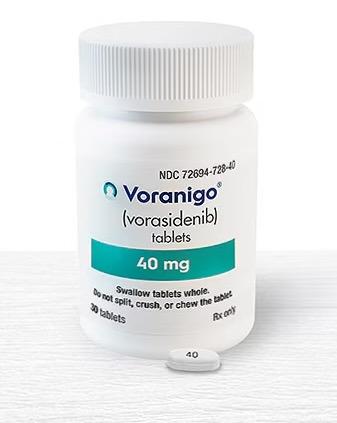Vorasidenib Side Effects
Medically reviewed by Drugs.com. Last updated on Oct 10, 2024.
Applies to vorasidenib: oral tablet.
Important warnings
This medicine can cause some serious health issues
Use only as directed.
Tell your doctor if you use other medicines or have other medical conditions or allergies.
Get emergency medical help if you have signs of an allergic reaction: hives, difficult breathing, swelling of your face, lips, tongue, or throat.
Call your doctor at once if you have:
-
liver problems--loss of appetite, nausea, vomiting, stomach pain (upper right side), tiredness, itching, dark urine, clay-colored stools, jaundice (yellowing of the skin or eyes).
Your cancer treatments may be reduced, delayed, or permanently discontinued if you have certain side effects.
Common side effects may include:
-
seizures;
-
abnormal liver function tests;
-
feeling weak or tired;
-
COVID-19 infection; or
-
muscle stiffness or aches.
This is not a complete list of side effects and others may occur. Call your doctor for medical advice about side effects.
For healthcare professionals
Applies to vorasidenib: oral tablet.
General adverse events
The most common adverse reactions included fatigue, headache, COVID-19, musculoskeletal pain, diarrhea, nausea, and seizure. Common grade 3 or 4 laboratory abnormalities included increased ALT, increased AST, increased GGT, and decreased neutrophils.[Ref]
Gastrointestinal
- Very common (10% or more): Diarrhea (up to 25%), nausea (up to 20%), constipation (up to 13%), abdominal pain (up to 13%)
Diarrhea included soft feces and frequent bowel movements.
Abdominal pain included upper abdominal pain, abdominal discomfort, lower abdominal pain, abdominal tenderness, and epigastric discomfort.
Hematologic
- Very common (10% or more): Decreased neutrophils (up to 14%), increased hemoglobin (up to 13%), decreased leukocytes (up to 13%), decreased platelets (up to 12%), decreased lymphocytes (up to 11%)
Hepatic
- Very common (10% or more): Increased ALT (up to 59%), increased AST (up to 46%), increased GGT (up to 38%)
- Common (1% to 10%): Increased bilirubin
- Frequency not reported: Criteria met for Hy's law, autoimmune hepatitis, hepatic failure
In the pooled safety population, increased ALT and AST occurred in 58% and 44% of patients, respectively; 9% and 4.8% had grade 3 or 4 increased ALT and AST, respectively. Among these patients, 4.1% had concurrent grade 3 to 4 ALT or AST elevations. Increased GGT, bilirubin, and alkaline phosphatase occurred in 34%, 4.8%, and 9% of patients, respectively, with 2.2%, 0.4%, and 0.9%, respectively, reported as grade 3 or 4.
Laboratory criteria for Hy's law was met in 2 patients who had concurrent elevations in ALT or AST greater than 3 times the upper limit of normal (3 x ULN) and total bilirubin greater than 2 x ULN; these events were associated with cases of autoimmune hepatitis and hepatic failure. The median time to first onset of increased ALT or AST was 57 days (range: 1 to 1049).
Permanent discontinuation of this drug was required for 2.9% of patients with increased ALT, 1.6% with increased AST, and 0.4% with increased GGT. Dosage reductions were required for 7%, 1.2%, and 0.4% of patients with increased ALT, AST, and GGT, respectively. Dosage interruptions were required in 14%, 6%, and 1.6% of patients with increased ALT, AST, and GGT, respectively.
Metabolic
- Very common (10% or more): Increased glucose (up to 10%)
- Common (1% to 10%): Decreased appetite
Increased glucose included hyperglycemia.
Musculoskeletal
- Very common (10% or more): Musculoskeletal pain (up to 26%)
Musculoskeletal pain included arthralgia, back pain, noncardiac chest pain, pain in extremity, myalgia, neck pain, musculoskeletal chest pain, arthritis, and musculoskeletal stiffness.
Nervous system
- Very common (10% or more): Headache (up to 28%), seizure (up to 16%)
Seizure included partial seizures, generalized tonic-clonic seizure, epilepsy, clonic convulsion, and simple partial seizures.
Other
- Very common (10% or more): Fatigue (up to 37%), increased potassium (up to 23%), decreased calcium (up to 10%), increased alkaline phosphatase (up to 10%)
- Common (1% to 10%): Decreased phosphate
Fatigue included asthenia.
Decreased phosphate included hypophosphatemia and decreased blood phosphorus.
Renal
- Very common (10% or more): Increased creatinine (up to 11%)
Respiratory
- Very common (10% or more): COVID-19 (up to 33%)
References
1. (2024) "Product Information. Voranigo (vorasidenib)." Servier Pharmaceuticals LLC
More about vorasidenib
- Check interactions
- Compare alternatives
- Dosage information
- During pregnancy
- Drug class: miscellaneous antineoplastics
- En español
Patient resources
Other brands
Professional resources
Other brands
Related treatment guides
Further information
Vorasidenib side effects can vary depending on the individual. Always consult your healthcare provider to ensure the information displayed on this page applies to your personal circumstances.
Note: Medication side effects may be underreported. If you are experiencing side effects that are not listed, submit a report to the FDA by following this guide.

